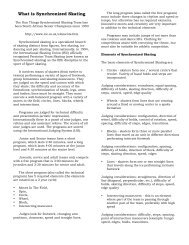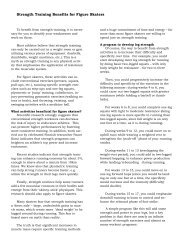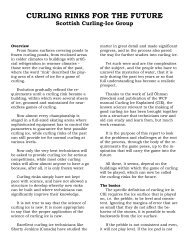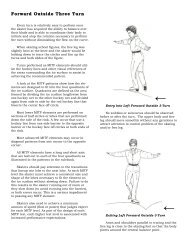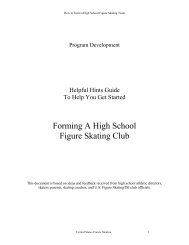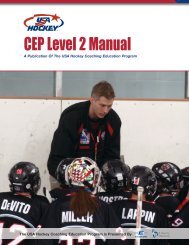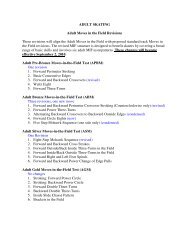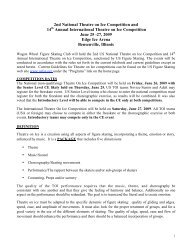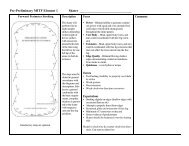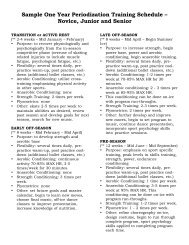IJS Presentation Guidelines - Ice skating resources
IJS Presentation Guidelines - Ice skating resources
IJS Presentation Guidelines - Ice skating resources
You also want an ePaper? Increase the reach of your titles
YUMPU automatically turns print PDFs into web optimized ePapers that Google loves.
<strong>IJS</strong> <strong>Presentation</strong> <strong>Guidelines</strong><br />
Currently the <strong>IJS</strong> Program<br />
Component <strong>Guidelines</strong> direct judges to<br />
evaluate everything contained in the<br />
program as part of the five following<br />
separate classifications –<br />
Skating Skills –Overall quality of<br />
<strong>skating</strong> performance<br />
o Balance - Ability to maintain the<br />
run on the blade while changing<br />
position.<br />
o Flow - Effortless glide, rhythmic,<br />
strong, clean strokes.<br />
o Sureness of edges, steps, and turns<br />
- Clean, controlled curves, deep<br />
edges, and precise steps<br />
embodied by the efficient use of<br />
lean and effortless transfer of<br />
weight.<br />
o Mastery of multidirectional <strong>skating</strong> –<br />
Use of unexpected changes of<br />
direction filling all corners and<br />
areas of the ice surface with an<br />
interesting disbursement of jumps<br />
and spins.<br />
o Mastery of <strong>skating</strong> on one foot –<br />
demonstrating agility and quick<br />
acceleration combined with<br />
changes of lean and direction.<br />
Transitions – A creative linking of<br />
required elements<br />
o Variety of edges, steps, and turns<br />
o Difficulty<br />
o Intricacy<br />
o Quality<br />
Performance and Execution –<br />
Personal involvement<br />
o Carriage and body<br />
alignment/movement<br />
o Variation of speed<br />
o Variety and contrast<br />
o Projection and involvement of<br />
audience<br />
Choreography – Composition –<br />
communication with the audience<br />
o Use of personal and private space –<br />
ice coverage and pattern<br />
o Proportion<br />
o Identifiable purpose<br />
o Originality<br />
o Musical phrasing and form<br />
o Use of musical highlights<br />
Interpretation – Use of body<br />
movements and the musical score as<br />
an instrument of communication<br />
o Effortless movement to the musical<br />
score<br />
o Expression of the music’s style,<br />
rhythm, and character<br />
o Subtle use of the musical score –<br />
nuances and subtle variation to<br />
tempo, dynamics, and intensity.<br />
The Technical Panel calls the required<br />
technical content and establishes the<br />
levels of difficulty add to the base value.<br />
Judges evaluate the skater’s degree of<br />
success or failure in performing the<br />
required elements as Grades of Execution<br />
(GOEs).<br />
Technical elements, jumps, spins, and<br />
step/spiral sequences, contribute to the<br />
overall fabric, theme, and performance of<br />
the composition of a well-balanced<br />
program.<br />
<strong>IJS</strong> Program Components includes a<br />
separate classification for transitions<br />
evaluated as a separate skill. The<br />
problem is that one element can<br />
immediately precede another element as<br />
well as short and longer intervals<br />
recognized as transitions.<br />
Connections using only forward and<br />
back crossovers will receive very low<br />
transition marks. The elapsed time of the<br />
transition, the speed, difficulty and<br />
variety of edges, turns, and other moves<br />
(pivots, spread eagles, Ina Baurs, etc.)<br />
will result in higher scores.
Choreography and Interpretation are<br />
also considered separately, but the<br />
choice of music impacts both<br />
components.<br />
Program Components<br />
<strong>Guidelines</strong> provide judges with a<br />
standard to measure and evaluate<br />
competence in a test or competitive.<br />
<strong>Guidelines</strong> also provide a roadmap for<br />
coaches to teach their skaters.<br />
The program components and<br />
required technical elements in top<br />
performances that receive high marks<br />
are skillfully executed to create illusions<br />
in a extraordinary demonstration of the<br />
human spirit.<br />
Definitions of terms used by<br />
Choreographers:<br />
Choreographic Risk – Not being<br />
predictable in connecting body<br />
movement to difficulty technical skills<br />
through the selection and execution<br />
of uncommon themes.<br />
Communication – The ability of a skater<br />
to use their body in combination with<br />
the music score to convey the<br />
purpose or theme or the program.<br />
Difficulty – The level of skill difficulty is<br />
established by the <strong>IJS</strong> and<br />
determined by the Technical Panel.<br />
Judges consider originality and apply<br />
their own determination of difficulty<br />
to the skater’s ability to perform the<br />
program components. Difficulty is<br />
rewarded when artistic performance<br />
is not sacrificed.<br />
Direction – The forward and backward,<br />
clockwise and counterclockwise use<br />
of the horizontal and vertical planes<br />
while performing turns that rotate in<br />
both directions.<br />
Duration – The use of slow or fast motion<br />
in combination of brief or extended<br />
measures of music.<br />
Emotional energy – The skater’s<br />
emotional investment in performing<br />
the program.<br />
Expression – Effectively conveying<br />
specific feelings.<br />
Finesse - Refinement, delicacy and artful<br />
manipulation of nuance.<br />
Gesture – An effective use of body<br />
movements that are not miming.<br />
Grace – An elegance of movement<br />
Intricacy – A sign of advanced proficiency<br />
is when a complex program is well<br />
executed and doesn’t look difficult.<br />
Level – Body movements that effectively<br />
use high, medium, and low space.<br />
Melodic Pattern - The relationship of the<br />
music’s melodic patterns and the<br />
<strong>skating</strong>.<br />
Motivation – Purposeful movement<br />
throughout the program of all parts<br />
contributes to the whole performance.<br />
Originality - The ability to present a new<br />
and unique choreographic idea.<br />
Parts – The continuous use of the whole<br />
body including face expressions and<br />
hand gestures.<br />
Phrasing – The placement of associating<br />
musical high and low points with the<br />
skater’s technical ability to achieve an<br />
overall climax at the end of the<br />
program.<br />
Physical and emotional involvement –<br />
Requires the skater to dissolve the<br />
barrier between the skater and their<br />
<strong>skating</strong>. A oneness with the music.<br />
Physical energy – The skater’s ability to<br />
provide the appearance of<br />
effortlessness throughout the<br />
performance. Performed with an<br />
economy of movement with no wasted<br />
effort.<br />
Place and Pathway – Imaginative,<br />
unpredictable, and unexpected paths<br />
used to cover the ice with three<br />
dimensional and 360 degree body<br />
movements.<br />
Projection – An emotional connection<br />
with the audience that sometimes is<br />
expressed by the audience clapping in<br />
time with the music. Receives a<br />
standing ovation at the end of the<br />
program.
Purpose – The ability to reveal a coherent<br />
theme as the program is performed.<br />
Quality – The use of movements that<br />
exhibit a high degree of competence<br />
and self-confidence. Poorly executed<br />
moves should be reflected in low<br />
marks.<br />
Rhythm – The relationship a skater<br />
establishes to the meter of the music<br />
Rhythmic Pattern - The relationship of<br />
the skater’s performance to the<br />
rhythmic patterns provided by the<br />
music.<br />
Shapes – Clear, imaginative, and<br />
expressive uses of the body.<br />
Size – A description of a skater’s<br />
movement as large, medium, or small.<br />
Speed – The speed over the ice that ebbs<br />
and flows appropriately to provide the<br />
maximum effect to show off and<br />
connect each technical element.<br />
Steps – Skating actions that include:<br />
gliding, sliding, turning, jumping,<br />
hopping, toe work etc.<br />
Style – The impression a skater conveys<br />
with their movement over the ice that<br />
is reflective of the skater’s personality.<br />
Tempo – A steady or constant execution<br />
of the musical score by the conductor<br />
of the orchestra who recorded the<br />
musical arrangement.<br />
Timing – The ability of the skater to<br />
respond to the underlying beat.<br />
Use of Energy – The ability of a skater to<br />
manipulate real or apparent physical<br />
and emotional energy.<br />
Use of Space – A skater’s ability to use<br />
personal and private space, the ice<br />
surface, and communicate with the<br />
audience.<br />
Use of the Body – The proficiency with<br />
which the skater can use facial<br />
expressions, head positions, arms,<br />
hands, <strong>skating</strong> and fee legs, plus a<br />
flexibility to bend sideways and both<br />
forward and backwards.<br />
Variety – The goal of competitive<br />
programs is to show figure <strong>skating</strong><br />
proficiency over a large range of<br />
complex body movements and<br />
technical elements.



